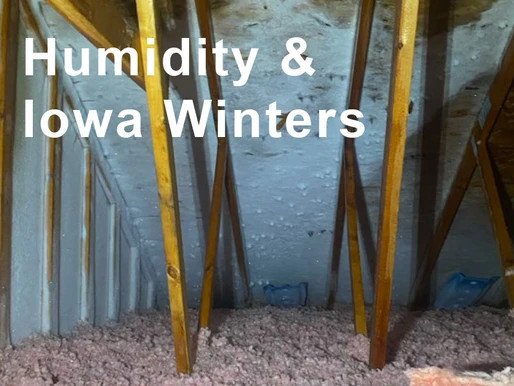As a roofing professional in Iowa, I’ve witnessed the effects of heat and humidity in an attic in Iowa and how they can impact a roof’s structural integrity. The Midwest summer brings sweltering heat and elevated humidity levels, while winter introduces extreme cold. These conditions, when they infiltrate your attic, can spawn a myriad of issues, jeopardizing your roof’s lifespan.
Here’s a breakdown of how heat and humidity in an attic cause issues and what homeowners can do to prevent them.
Understanding the Effect of Heat and Humidity on Your Attic
The attic is a vital part of your home’s structure, and it plays a critical role in regulating the temperature and air quality of your home. Assuming you have proper ventilation in your attic (more on that in this article), it typically stays warm enough in the summer to circulate any humidity from the living area of your home out of your attic. The real problem can be the winter months. In the winter, humidity from the living area of your home (or improperly vented items such as bathroom fans) condenses when it hits the much lower temperatures in your attic. In extremely low temperatures, this condensation can turn to frost on the underside of your roof deck and it can lead to the following issues:
- Shortened Lifespan of Your Roof: Frost/condensation on the roof deck in the winter can cause deck boards to rot and age faster than they normally would. The extreme heat and humidity in your attic in the summer can cause the shingles on your roof to warp, crack, and become brittle. This can lead to leaks, water damage, and an overall shortened lifespan of your roof.
- Mold and Mildew Growth: Mold and mildew thrive in warm, moist environments, and the hot and humid conditions in your attic during the summer can provide the perfect breeding ground for these unwanted visitors spawned from the condensation and frost build-up over the winter. Mold and mildew can eat away at the wood in your attic, causing structural damage that can compromise the overall health of your roof.
- Increased Energy Bills: When your attic is not properly insulated, the hot air from your attic can seep into your home, causing your air conditioner to work harder to regulate the temperature. This, in turn, can lead to higher energy bills and less comfortable living spaces.
Common Attic Issues Caused by Heat and Humidity
Now that we understand the impact of heat and humidity on your attic, let’s take a closer look at some of the most common issues that can arise as a result:
- Ice Damming: In the winter months, the heat from your attic can melt snow on your roof, which can then refreeze and form ice dams. These ice dams can cause water to back up under your shingles, leading to leaks and water damage.
- Poor Indoor Air Quality: When mold and mildew grow in your attic, they can release spores into the air, which can lead to poor indoor air quality. This can cause respiratory issues for you and your family, especially for those with allergies or asthma.
How to Prevent Issues Caused by Heat and Humidity in Your Attic
Fortunately, there are steps you can take to prevent issues caused by heat and humidity in your attic. Here are a few tips:
- Install Proper Ventilation: A well-ventilated attic can help regulate the temperature and humidity levels in your attic. This can prevent mold and mildew growth, reduce energy bills, and extend the lifespan of your roof.
- Improve Insulation: Proper insulation can help keep the heat in your attic from seeping into your home, reducing your energy bills and keeping your living space comfortable.
- Regular Maintenance: Regular inspections and maintenance of your roof and attic can help detect issues before they become major problems. JB Roofing & Gutters can provide an expert opinion on the health of your roof and attic and make recommendations for repairs or upgrades to prevent issues caused by heat and humidity. An attic inspection once per winter is also key here in Iowa, specifically in the very low-temperature days of the season.
FAQs
How do I know if there is mold or mildew in my attic?
You may notice a musty smell or see visible signs of mold or mildew growth in your attic. It’s best to have a professional inspection to determine the extent of the issue and the best course of action.
How often should I have my roof and attic inspected?
It’s recommended to have your roof and attic inspected at least once a year to detect any issues before they become major problems.
Conclusion
As a roofing professional in Iowa, I have seen the detrimental effects that heat and humidity can have on a roof and attic. Mold and mildew growth, increased energy bills, and a shortened lifespan of your roof are just a few of the issues that can arise as a result of high levels of heat and humidity in your attic. However, by installing proper ventilation, improving insulation, and conducting regular maintenance, you can prevent these issues and ensure the longevity of your roof.
Don’t wait until it’s too late – take action today to protect your home from the damaging effects of heat and humidity in your attic. Give JB Roofing & Gutters a call today!

About the Author
Joe Burkhart, the driving force behind JB Roofing, has been a trusted roofing expert in Ankeny, IA, since 2006. Joe’s passion for quality craftsmanship and personalized service comes from over 20 years of hands-on experience, starting his journey in the roofing industry back in the early 1990s. JB Roofing is more than just a business to Joe—it’s a reflection of his commitment to providing reliable, long-lasting roofs that protect homes and families across Iowa.

